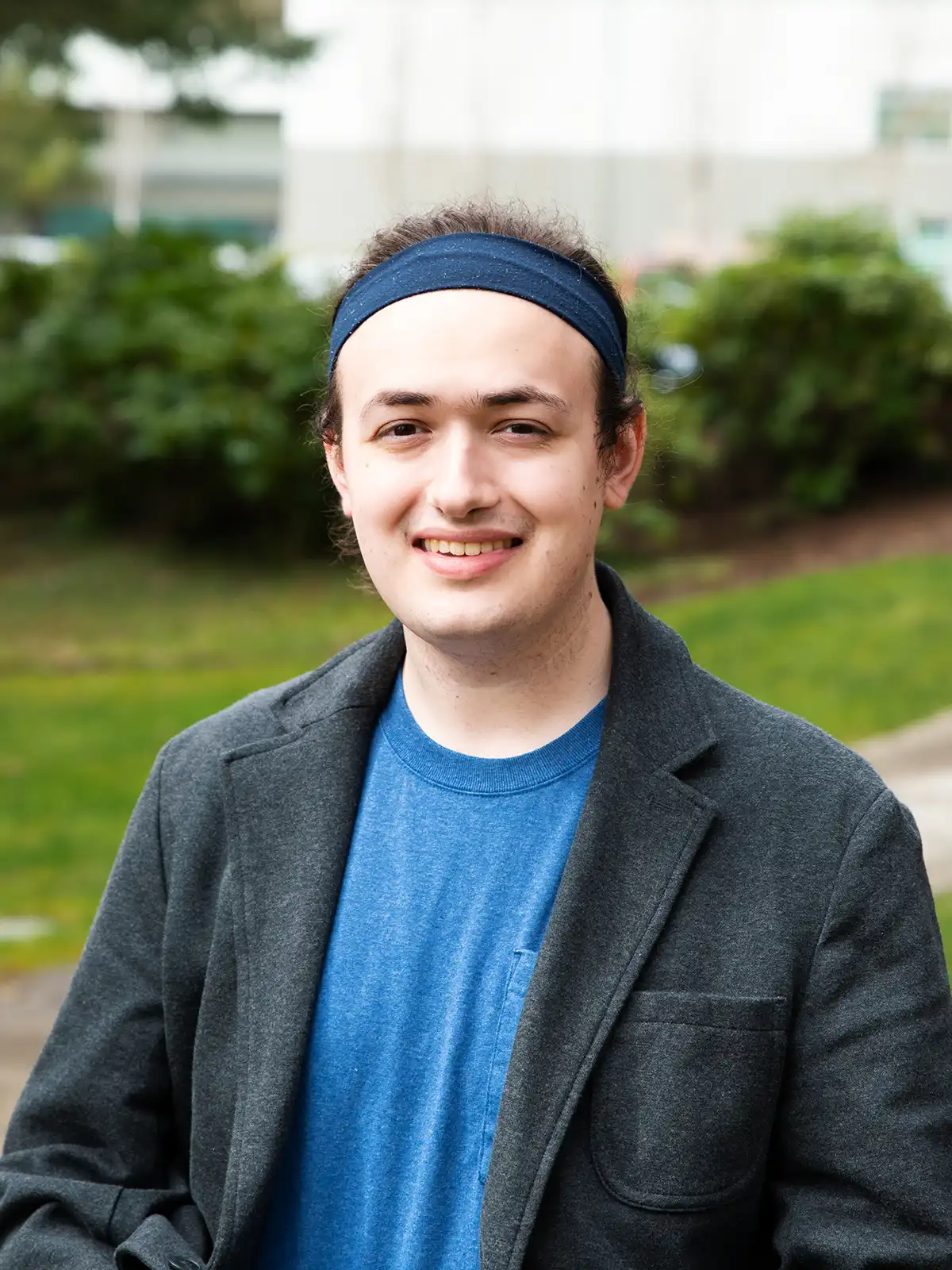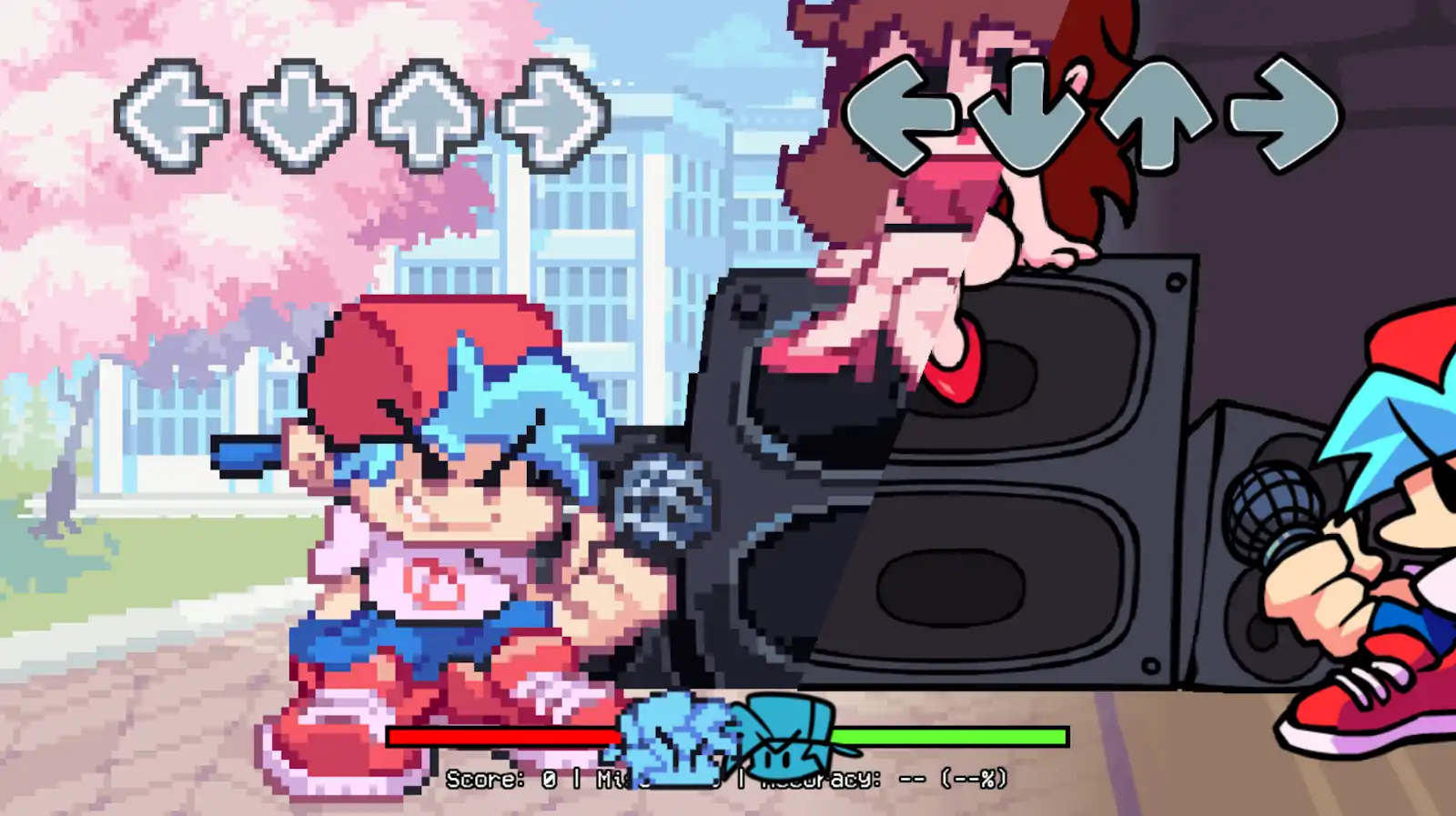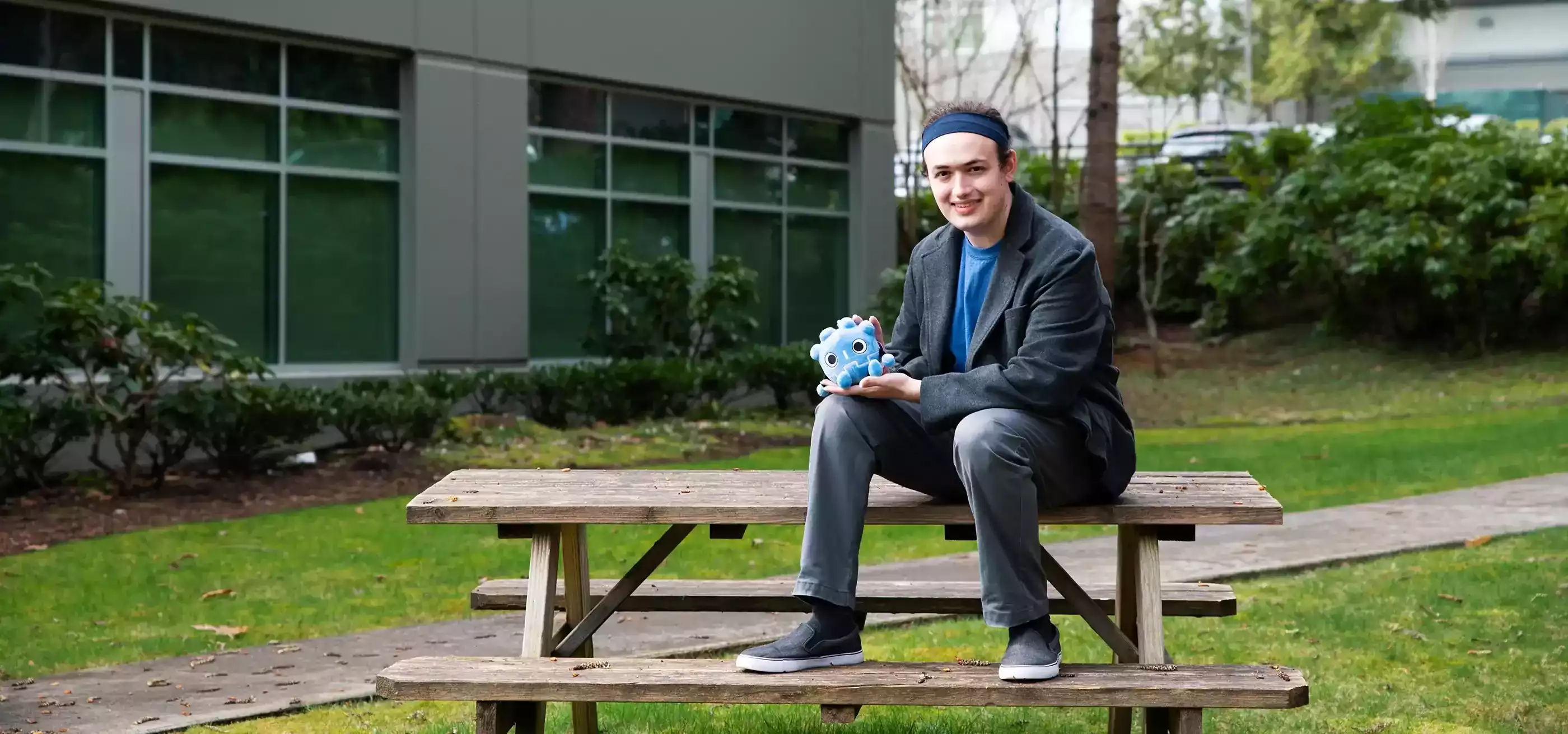Over the past four years, Ben Kurtin has become a familiar face to many fellow Dragons on campus, well known for their trademark headband, outgoing personality, and passion for making games.
“The moment I got my hands on a video game, I knew that I wanted to make them,” Kurtin, who graduated last April from the BS in Computer Science and Game Design program, says. “I love combining the nebulous side of design into the practical side of programming and making the core of a game come to life.”
With 13 game projects highlighted on their portfolio website, it’s clear Kurtin has been doing just that for quite a while now — experimenting with a range of genres, design ideas, and software tools along the way. They’ve made 2D and 3D rhythm-action games, point-and-click adventure games, side-scrolling platformers, and more.
According to Kurtin, however, all these projects might never have come to fruition if not for the help of a piece of software called the Godot game engine, which provided the momentum Kurtin needed to get going roughly five years ago. It helped them so much, in fact, that Kurtin has also become known to their Dragon peers as something of an in-house Godot expert and evangelist.
“I didn’t have my footing until I got to high school and I started learning computer science for the first time. I took AP Computer Science, and that’s when the sparks really started to fly, because programming just came naturally to me,” Kurtin says. “Then I started experimenting with Unity and other types of game engines.”

If you’re unfamiliar with what a “game engine” is, you can think of it as the invisible entity that powers the game experience and makes everything you see and hear on screen possible. By integrating essential systems and functions such as graphics, level editing, AI behavior, physics simulation, and more, a successful engine can be used again and again as the basis for any number of different game projects.
“It’s the foundation for a video game,” Kurtin says. “You can make a video game from scratch, but it’s much easier if you have things like graphics and audio and physics to work off of to build your experience.”
For any game developer looking to begin a project, selecting an engine is an important step. While some commercial engines such as Unity and Unreal Engine have practically become household names thanks to their widespread adoption, both in the game industry and beyond, they are far from the only options available.
Then I found Godot. It was one of these up and comers that was, at the time, still pretty unknown compared to other game engines.
Unfortunately, Kurtin says, almost all of the engines they tried working with as a high school student failed to click. “A lot of the time I found the user experience of these engines to be clunky and slow and hard to digest,” Kurtin says. “Making game content inside of these engines was frustrating. It just wasn’t what I wanted.”
Then, with the arrival of the COVID-19 pandemic in 2020, something changed. After graduating from high school earlier than expected, Kurtin decided to make use of the extra free time to explore their options once again.
“Then I found Godot. It was one of these up and comers that was, at the time, still pretty unknown compared to other game engines,” Kurtin says. “I was like, ‘I might as well give this a shot to see how it is.’ I fell in love with it, and I’ve been using it as my primary game engine ever since.”
Originally developed in Argentina and released to the public in 2014, the Godot engine has distinguished itself in part for being an open-source platform — available for any developer to use and modify as they see fit without having to pay royalties or licensing fees. Capable of powering both 2D and 3D game experiences, it’s an engine that’s been steadily attracting the attention of both independent creators and larger game studios alike.
“The real thing that proves an engine’s worth, or any tool’s worth really, is the stuff that’s made from it. And Godot in recent years has had quite a few titles made in it that has piqued many people’s interest in wider-spread adoption of the engine,” Kurtin says, pointing to some niche but popular titles like Cruelty Squad, WEBFISHING, and the upcoming game PVKK as a few notable examples.
For Kurtin, it was Godot’s clear documentation and comparable ease of use, such as the ability to make changes to a project in real-time, that made all the difference.
“What Godot does differently is focus on the developers,” Kurtin says. “Because it’s an open-source project, all these features that it has come directly from users of the engine, i.e. the developers.”

After building up some experience working on Godot-based game jam projects and a few solo endeavors, it wasn’t long before Kurtin took on a more ambitious project — recreating a popular open-source 2D rhythm game for VR headsets with the help of a few artists and musician friends. That game, Friday Night Funkin’ VR, became a viral hit on TikTok and YouTube when it released the summer before Kurtin’s freshman year at DigiPen. Kurtin was even invited to share the story of the game’s development on the official Godot blog.
“Lots of people downloaded it and played it and gave me feedback on it, and it was the first time I made a huge group project,” Kurtin says.
In the years since that first major success, Kurtin has continued to explore other features and capabilities of the Godot engine, whether for DigiPen assignments or personal growth, sometimes creating entire games as a means to try out new things.
“I’ve done things like ‘mod’ loading or DLC loading via Godot’s pack extensions and asynchronous scene loading with progress bars,” Kurtin says. “I’ve done telemetry as well, so I can write data that’s happening in game to a file and then read that for playtesting or analysis purposes.”
Not only that, they’ve continued to spread the word of what Godot can do for others, including last year when Kurtin presented an hour-long talk titled “Stop Waiting for Godot” to a packed lecture room as part of the DigiPen Colloquium Speaker Series — typically reserved for faculty and industry guest speakers. Kurtin’s talk covered both the pros and potential limitations of working with Godot, with a helpful primer on additional tools and plugins developers can use to get the most out of the engine.
“I made a lot of revisions on the presentation. I also did a lot of practice,” Kurtin says. “I presented to my friends, and they gave me feedback about points that were unclear or things that I could word differently.”
In April 2024, Ben Kurtin gave a formal presentation on the features and benefits of the Godot game engine as a part of the DigiPen Colloquium Speaker Series on campus.
It’s also worth pointing out that, despite their personal preferences for Godot, it’s not the only engine Kurtin has used to make games since coming to DigiPen. As the technical director for the junior-level DigiPen game Goosthetic, now available on Steam, Kurtin helped the 22-person team Smilewire create a colorful movement-based first-person shooter using Unreal Engine 5. Prior to that, Kurtin also got to experience making a 2D top-down tower defense game in a custom-built engine.
“Once I started to build a game engine for myself and with my teammates, I really understood what goes on behind the scenes,” Kurtin says. “It is an incredibly complex task to make a general-purpose game engine that can create any kind of software that you’re thinking of.”
As of early June, just a few weeks after graduation, Kurtin was eager to announce having landed their first post-DigiPen job as an associate gameplay engineer at thatgamecompany, the indie studio behind Sky: Children of the Light and its recently announced follow-up, The Two Embers: Part One.
“The further along in the hiring process I was, the more I realized how in-sync the people at thatgamecompany and I were about making video games. They really care. They want to give meaningful experiences to everyone, even people who aren’t necessarily gamers,” Kurtin says. “It was like greeting a group of old friends. So to say I’m excited to work with them is an understatement!”
In the meantime, Kurtin has no plans to stop recommending and connecting with fellow enthusiasts of the engine that launched their game dev journey in the first place.
“I want to use Godot to create the best games I can, when I have the time to, and be a part of its path towards a more open future for game development. That means it’s still the engine of choice for personal projects,” Kurtin says.
Speaking of connecting with other Godot users, a funny moment happened last fall. It was during an on-campus Company Day with Marvel Snap developer Second Dinner. Knowing that the Second Dinner team had recently announced they were working on some unannounced future game projects in the Godot game engine, Kurtin took the opportunity to ask the company presenters about any potential news or updates related to those projects.
“Both of the presenters were kind of like, ‘Well, you know, that’s kind of under wraps,’” Kurtin says. “And then [one of them] asked me, ‘So do you know about Godot?’ And then the entire room burst out in laughter, because everybody knows I am the Godot person.”
